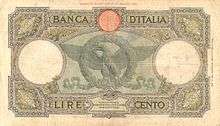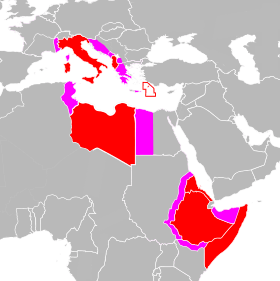Italian Ethiopia
.svg.png)
Italian Ethiopia was a colony of the Kingdom of Italy in the territory of present-day Ethiopia. It was formally created in 1936 following the second Italo-Ethiopian War, with Victor Emmanuel III proclaiming himself Emperor of Ethiopia. The occupation lasted until the Allies conquered the Italian East Africa in 1941 and it officially ended in 1947, when the Peace Treaty was signed.
Characteristics

Since May 1936 Italian Ethiopia was part of the newly created Africa Orientale Italiana (AOI), or Italian East Africa, and administratively was made of four governorates: Governorate of Amara, Governorate of Harrar, Governorate of Galla-Sidamo and Governorate of Shewa. Each Governorate was under the authority of an Italian governor, answerable to the Italian viceroy, who represented the Emperor Victor Emmanuel The territory around the capital was renamed in 1939 Governorate of Scioa: originally it was called "Governorato di Addis Abeba", but in 1939 the name was changed to show the region of Scioa around the area of Addis Abeba. This was done because areas of the nearby governorates of Harrar, Gallo-Sidamo and Amhara were included in it. Italian Ethiopia had an area of 305,000 square miles and a population of 9,450,000 inhabitants, resulting in a density of 31 per square mile[1]
| Governorate | Italian name | Capital | Total population | Italians[2] | Car Tag | Coat of Arms |
|---|---|---|---|---|---|---|
| Amhara Governorate | Amara | Gondar | 2,000,000 | 11,103 | AM | |
| Harrar Governorate | Harar | Harrar | 1,600,000 | 10,035 | HA | |
| Galla-Sidamo Governorate | Galla e Sidama | Jimma/Gimma | 4,000,000 | 11,823 | GS | |
| Shewa Governorate | Scioà | Addis Abeba | 1,850,000 | 40,698 | SC | |
Some territories of the defeated Kingdom of Etiopia were added to Italian Eritrea and Italian Somalia inside AOI, because mainly populated by Eritrean and Somalian populations (but even as a reward to their colonial soldiers who fought in the Italian Army against the Negus troops).
The currency used was the Italian East African lira: the Lira AOI was a special banknote (of 50 lire and 100 lire) circulating in AOI between 1938 [3] and 1941:
| Frontal Image | Back Image | Amount | Color | Frontal Description | Back Description |
|---|---|---|---|---|---|
 |
 |
50 Lire | Green | LIRE CINQVANTA - BANCA D'ITALIA | 50 LIRE - Lupa romana |
 |
 |
100 Lire | Green/gray | LIRE CENTO - BANCA D'ITALIA - Dea Roma | LIRE CENTO - BANCA D'ITALIA - Aquila |
On 5 May 1936 the capital Addis Ababa was captured by the Italians: on 22 May three new stamps showing the King of Italy were issued. Four further values inscribed "ETIOPIA" were issued on 5 December 1936. After that date, the stamps were issued with the name "Africa Orientale Italiana" on it.[4]
See also
- Italian East Africa topics
- Italians of Ethiopia
- Italian Eritrea
- Italian Somalia
- Linea dell'Impero
- Prince Amedeo, Duke of Aosta
Notes
- ↑ Royal Institute of International Affairs (24 August 1940). "Italian Possessions in Africa: II. Italian East Africa". Bulletin of International News. 17 (17): 1065–1074.
- ↑ Istat Statistiche 2010
- ↑ Bank of Italy
- ↑ Postage stamps of Italian Ethiopia
Bibliography
- Bandini, Franco. Gli italiani in Africa, storia delle guerre coloniali 1882-1943. Longanesi. Milano, 1971.
- Beltrami, Vanni. Italia d'oltremare. Storie dei territori italiani dalla conquista alla caduta. Edizioni Nuova Cultura. Roma, 2013 ISBN 978-88-6134-702-1
- Dickson, Keith. World War II. Wiley Publishing. New York, 2001
- Jowett, Philip. The Italian Army 1940–45: Africa 1940–43. Osprey Publishing. London, 2001
- Sbiacchi, Alberto. Hailé Selassié and the Italians, 1941-43. African Studies Review, vol.XXII, n.1, April 1979.
